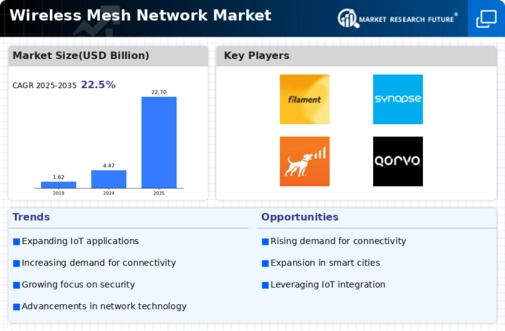Market Share
Wireless Mesh Network Market Share Analysis
The Wireless Mesh Network Market offers a diverse and competitive landscape for companies to implement various market share positioning strategies. Product Differentiation serves as a fundamental approach, with companies emphasizing the unique features and benefits of their wireless mesh network solutions. This may involve highlighting self-organizing capabilities, multi-hop routing protocols, or seamless integration with IoT devices. By showcasing these distinguishing factors, companies aim to stand out in the market and attract organizations seeking specific wireless mesh network enhancements for their communication infrastructure.
Cost Leadership is another significant strategy, where companies focus on offering wireless mesh network solutions at a competitive price point. This can be appealing to businesses and municipalities looking for cost-effective yet resilient networking solutions and can help companies gain market share by providing affordable yet reliable offerings. Market Segmentation plays a crucial role as well, with companies identifying and targeting specific sectors such as smart cities, industrial IoT, or public safety with tailored wireless mesh network offerings. By understanding the unique networking needs of different market segments, companies can position their products to address specific connectivity challenges and gain a larger share within those niches.
Innovation is a driving force in the Wireless Mesh Network Market, with companies constantly seeking to introduce cutting-edge technologies such as dynamic spectrum utilization, edge computing integration, and AI-driven network optimization. By staying ahead of the curve and offering novel solutions, companies can capture the attention of organizations seeking advanced networking capabilities and establish a strong market presence. Partnerships and Alliances are also instrumental, as companies collaborate with network infrastructure providers, IoT platform vendors, or smart city solution integrators to enhance their market share. By forming strategic alliances and integrating their wireless mesh network solutions with complementary services, companies can expand their reach and influence in the market, leveraging the strengths of their partners.
Customer Experience and Support are critical factors that can impact market share positioning in the wireless mesh network sector. Companies that prioritize user-friendly network management interfaces, seamless deployment processes, and responsive customer support can attract and retain a larger client base, ultimately strengthening their position in the Wireless Mesh Network Market. By providing exceptional customer experiences, companies can build long-term relationships and trust, leading to increased market share.
Marketing and Communication efforts also play a vital role in shaping market share positioning. Companies engage in industry-specific advertising, participation in technology conferences, and thought leadership content. These efforts aim to increase visibility, build brand recognition, and establish a strong presence in the wireless mesh network market. By effectively communicating the value of their networking solutions to the target audience, companies can influence purchasing decisions and gain a competitive edge.







Leave a Comment